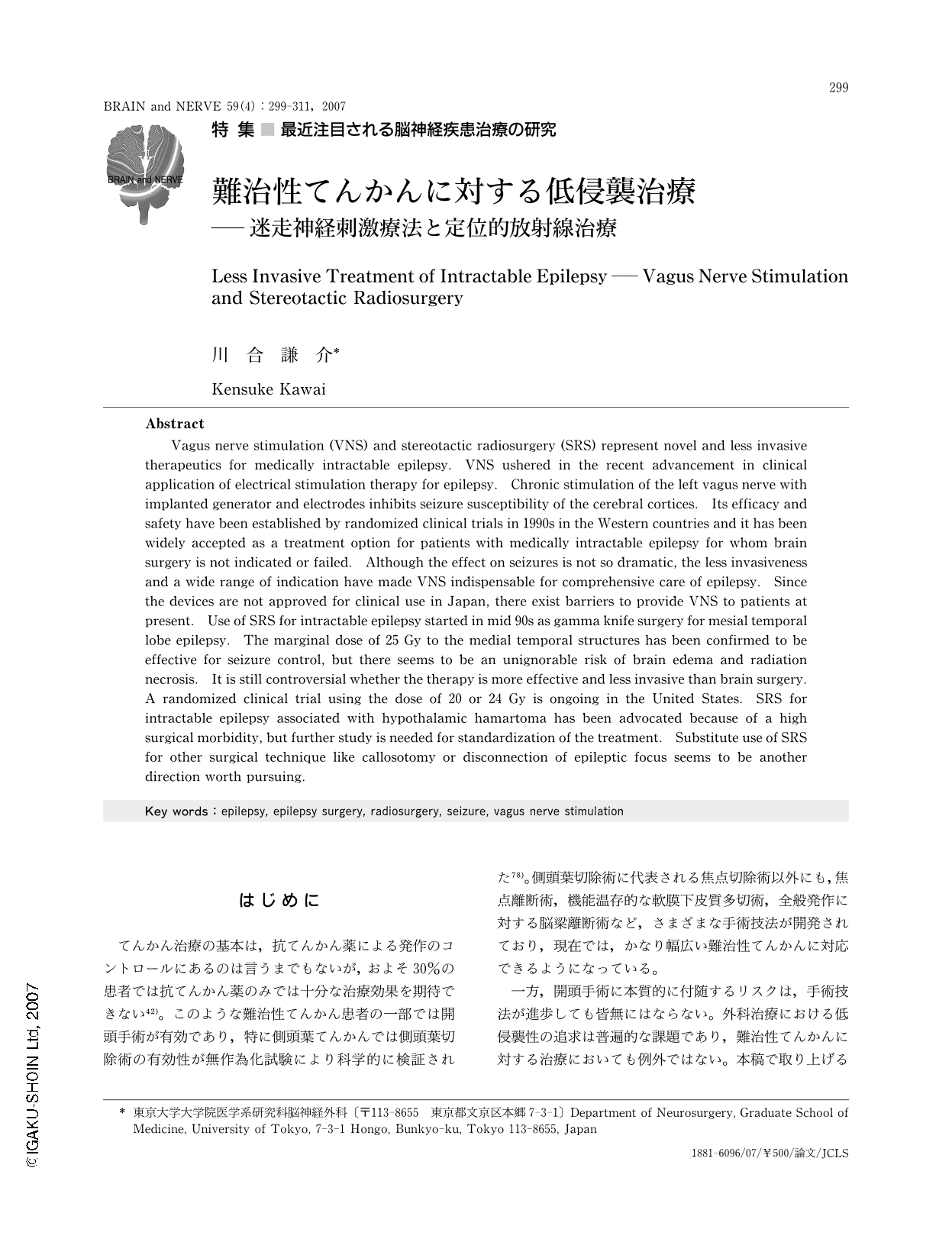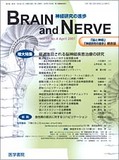Japanese
English
- 有料閲覧
- Abstract 文献概要
- 1ページ目 Look Inside
- 参考文献 Reference
はじめに
てんかん治療の基本は,抗てんかん薬による発作のコントロールにあるのは言うまでもないが,およそ30%の患者では抗てんかん薬のみでは十分な治療効果を期待できない42)。このような難治性てんかん患者の一部では開頭手術が有効であり,特に側頭葉てんかんでは側頭葉切除術の有効性が無作為化試験により科学的に検証された78)。側頭葉切除術に代表される焦点切除術以外にも,焦点離断術,機能温存的な軟膜下皮質多切術,全般発作に対する脳梁離断術など,さまざまな手術技法が開発されており,現在では,かなり幅広い難治性てんかんに対応できるようになっている。
一方,開頭手術に本質的に付随するリスクは,手術技法が進歩しても皆無にはならない。外科治療における低侵襲性の追求は普遍的な課題であり,難治性てんかんに対する治療においても例外ではない。本稿で取り上げる迷走神経刺激療法(vagus nerve stimulation: VNS)も定位的放射線治療も,薬剤抵抗性の難治性てんかんに対して開頭手術を行うことなく,より低い侵襲で治療を行おうという治療法である。
精神神経疾患に対する電気刺激療法の最近の進歩普及にはめざましいものがある。てんかん治療においても,脳深部刺激療法やてんかん焦点電気刺激療法などの臨床応用がすでに進められているが2,74),VNSはまさにその先駆的な存在である。本療法は,体内埋め込み式の刺激装置により慢性的かつ間歇的に左頸部迷走神経を刺激し,大脳皮質の抑制機構を高め,てんかん発作を減少させる。欧米では大規模治験によりその有効性と安全性が確認され,薬剤治療が無効で開頭手術の対象とならない,または開頭手術が無効であった難治性てんかん患者に対して,すでに広く用いられている10)。一方,実質的に世界で唯一の未承認国である日本では,今もなお施行に多くの障壁があり,早期の薬事法承認が待たれる34)。
定位的放射線治療は,病変に対してきわめて選択的・集中的な放射線照射を行うもので,脳腫瘍や脳動静脈奇形の治療に広く用いられている。コバルト60線源のガンマ線を利用したガンマナイフがその代表であり,難治性てんかんに対する応用は,1990年代中頃に内側側頭葉焦点に対するガンマナイフ治療として始まった66)。海馬・海馬傍回・扁桃体の一部へ辺縁線量約25Gyの照射を行えば,ほぼ切除手術に匹敵する発作抑制効果が得られることが確認されたが,放射線障害の可能性があること,効果発現機序が十分解明されていないこと,長期成績が不明であること,などの理由から,いまだ評価は定まっておらず,現在も治験が進められている34)。一方,視床下部過誤腫に伴う難治性てんかんへの応用は比較的広く行われるようになってきたが,他の治療法と比較した場合の評価はやはり未確定である。また最近では,てんかん手術の一手法である白質線維離断にガンマナイフを応用した報告もなされており,単なるてんかん焦点破壊法から焦点離断手術の代替として,さらに開頭手術と組み合わせた相補的治療法として,現在も発展しつつある。
Abstract
Vagus nerve stimulation (VNS) and stereotactic radiosurgery (SRS) represent novel and less invasive therapeutics for medically intractable epilepsy. VNS ushered in the recent advancement in clinical application of electrical stimulation therapy for epilepsy. Chronic stimulation of the left vagus nerve with implanted generator and electrodes inhibits seizure susceptibility of the cerebral cortices. Its efficacy and safety have been established by randomized clinical trials in 1990s in the Western countries and it has been widely accepted as a treatment option for patients with medically intractable epilepsy for whom brain surgery is not indicated or failed. Although the effect on seizures is not so dramatic, the less invasiveness and a wide range of indication have made VNS indispensable for comprehensive care of epilepsy. Since the devices are not approved for clinical use in Japan, there exist barriers to provide VNS to patients at present. Use of SRS for intractable epilepsy started in mid 90s as gamma knife surgery for mesial temporal lobe epilepsy. The marginal dose of 25 Gy to the medial temporal structures has been confirmed to be effective for seizure control, but there seems to be an unignorable risk of brain edema and radiation necrosis. It is still controversial whether the therapy is more effective and less invasive than brain surgery. A randomized clinical trial using the dose of 20 or 24 Gy is ongoing in the United States. SRS for intractable epilepsy associated with hypothalamic hamartoma has been advocated because of a high surgical morbidity, but further study is needed for standardization of the treatment. Substitute use of SRS for other surgical technique like callosotomy or disconnection of epileptic focus seems to be another direction worth pursuing.

Copyright © 2007, Igaku-Shoin Ltd. All rights reserved.


